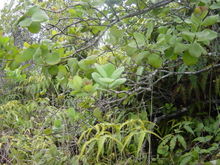| Santalum | |
|---|---|

| |
| The branches of a young Santalum paniculatum on the island of Hawaiʻi | |
| Scientific classification | |
| Kingdom: | Plantae |
| Clade: | Tracheophytes |
| Clade: | Angiosperms |
| Clade: | Eudicots |
| Order: | Santalales |
| Family: | Santalaceae |
| Genus: | Santalum L. |
| Species | |
|
See text | |
| Synonyms[1] | |
| |
Santalum is a genus of woody flowering plants in the Santalaceae family, the best known and commercially valuable of which is the Indian sandalwood tree, S. album. Members of the genus are trees or shrubs. Most are root parasites which photosynthesize their own food, but tap the roots of other species for water and inorganic nutrients. Several species, most notably S. album, produce highly aromatic wood, used for scents and perfumes and for herbal medicine. About 25 known species range across the Indomalayan, Australasian, and Oceanian realms, from India through Malesia to the Pacific Islands, as far as Hawaiʻi and the Juan Fernández Islands off the coast of South America.
Indian sandalwood (S. album) is found in the tropical dry deciduous forests of India, the Lesser Sunda Islands of Indonesia, and Arnhem Land of northern Australia. It is the only species of the genus found on the Asian mainland, and may have been introduced to India from the Lesser Sundas centuries ago. Indian sandalwood has been stripped from most of India's forests, and is now rare in the wild. Five species, including S. album, are native to Australia. S. acuminatum, known as the sweet quandong or native peach, produces a shiny bright red fruit used increasingly in Australia for jams, jellies, chutneys, and pies. Four species, commonly called ʻiliahi, are endemic to Hawaiʻi. S. fernandezianum, endemic to the Juan Fernández Islands off the coast of Chile, was also overexploited for its aromatic wood, and may now be extinct.
Santalum species are used as food plants by the larvae of some Lepidoptera species, including Endoclita malabaricus.
- ^ Santalum L. Plants of the World Online. Retrieved 12 November 2023.